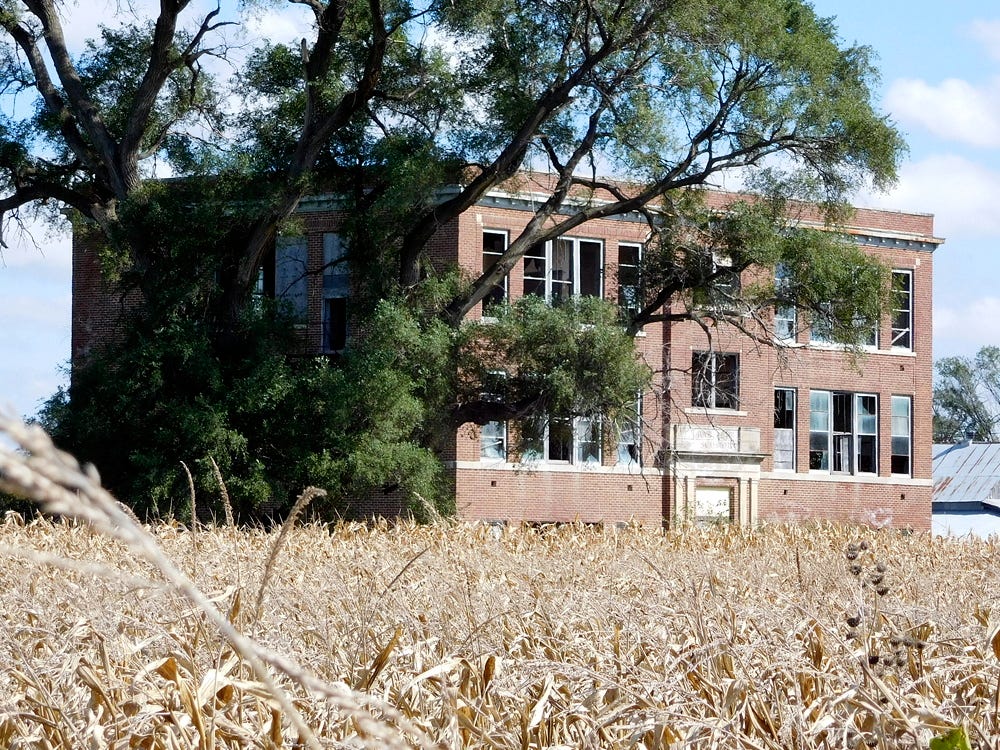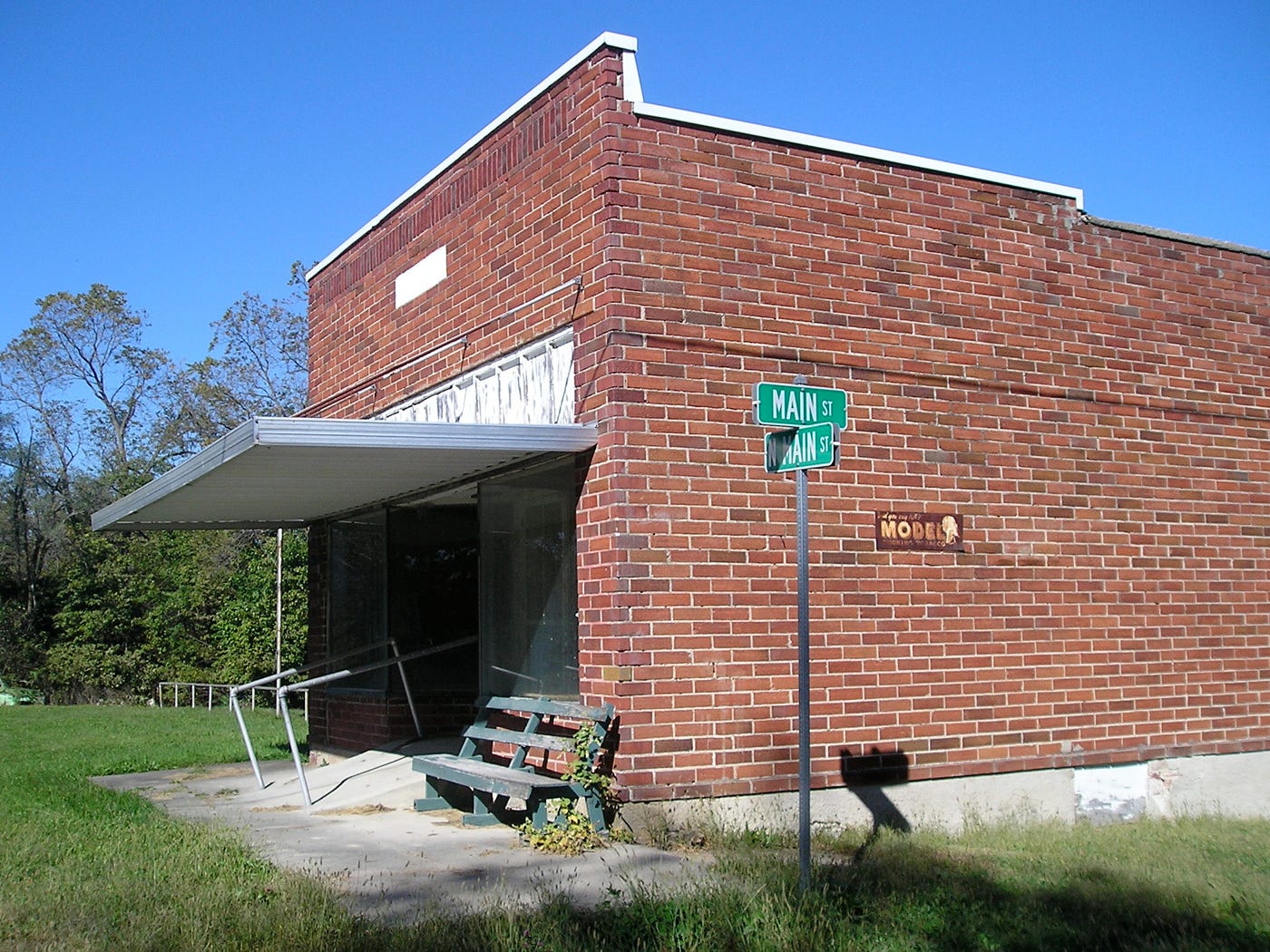Part of an intermittent series
Sections about Carter Lake and the Missouri border marker were split off into a separate piece.
Instead of going through downtown Omaha, I drove north on Abbott Drive, which becomes John J. Pershing Drive. Pershing, an adopted son of Nebraska, was General of the Armies during World War I. Pershing’s boyhood home in Laclede, Missouri, is also worth a visit. After crossing back into Iowa from North Omaha, I followed I-29, then in the middle of the massive Council Bluffs Interstate System reconstruction project. Nine years later, it is for the most part complete.
Between the U.S. Highway 34 and Pacific Junction exits on I-29 in 2015 was an unfortunate juxtaposition. There was a billboard for a strip club in Hamburg that was engaged in a yearslong fight over whether it could be classified as a “theater” and thus exempted from a statewide ban of public nudity. The Iowa Supreme Court didn’t rule directly on that, but did say that state law pre-empted city ordinances on nude dancing.
The billboard after that was for “Mom Approved” restrooms at the Sapp Bros. truck stop at the Iowa Highway 2 exit. As of June 2023, it’s still there.

The Bartlett school was the second one of the day after Pacific Junction. Its front does not face County Road J10, but instead faces south to a road that’s not there anymore. I researched the building years later, after the Tabor and Glenwood newspaper archives became available online. Bartlett, Randolph, Tabor, and Thurman consolidated into the Fremont-Mills school district in 1959. A district without Thurman almost was approved in May 1958, but Bartlett’s two-vote-margin in opposition sank it. In 1961, by a 3-2 vote, the Fremont-Mills board voted to close the Bartlett school. It only had 26 students in its last year.
After Bartlett I was back on the Loess Hills Scenic Byway, following the edge of the hills again, except for going through Waubonsie State Park. The byway is signed south to the state line.
The Hamburg High School complex isn’t abandoned, but it isn’t a school anymore. Hamburg was caught in the fallout when the Farragut school district got nuked by the Iowa Department of Education in the third forced dissolution in state history. Hamburg, which had been in whole-grade-sharing with Farragut as Nishnabotna High School, was reduced to having only grades K-8 at Marnie Simons Elementary. Hamburg opened a charter school in 2022. It has a focus on career training.
From Hamburg to US 71, I traveled the straight line a mile and a quarter north of the state line that, in various places at various times, was part of Iowa Highway 333. The fight to pave this road is a fascinating story that involves a designation of Iowa Highway 999. I wrote about it in 2019.
Did you know you can go to Siam without leaving Iowa? In southwest Taylor County, just north of the intersection of county roads J55 and N26, is a not-even-a-map-dot with one church, named before modern Thailand came about. Siam is important, or perhaps “important,” enough, that J55 and N26 are paved to its east and north, respectively, but are gravel in the other two directions. This creates a gap to paved roads in Page County.
Downtown Bedford has brick streets and an offset, picturesque courthouse square. Going around and in Iowa’s historic courthouses is always a treat. A blogger writing as the Iowa Gallivant visited Lenox, Bedford, and the Missouri border marker in 2021.

The town of Athelstan, right by the “southernmost” part of the Iowa-Missouri line west of Lee County, disincorporated in 2004. Red Oak native Christopher Solberg wrote in 2021 about how, two years out of college, he was given the job of drawing up papers to end Athelstan’s existence — its last will and testament. The experience inspired Solberg to start Rural Resurrection, “a blog about saving small-town America.”
Taylor County’s Freedom Rock is in downtown Blockton, a town abutting the Ringgold County line. Blockton, like Lincoln in Tama County, tells drivers to take the “next 5 exits.”
All that’s left of the ghost town of Caledonia are a cemetery and a few historical markers. Its final contribution to Iowa history was in 1933. A member of the Barrow gang — that is, Bonnie and Clyde’s gang — was spotted at Caledonia’s store. A farmer’s discovery of blood-stained clothing put law enforcement on the gang’s trail and led to the famous shootout near Dexter a day later.
I got to Lamoni earlier than expected. I wondered if there might be a football game in town that Friday night, and it turned out there was! Lamoni’s game against Twin Cedars of Bussey was played on the Graceland College field. The field had marker tape arranged for the 8-player game, which is played in a smaller area. Cheerleaders made up about a quarter of the visitor section for Twin Cedars, about 90 miles from Lamoni, at kickoff although more fans came later. Lamoni’s pep band was five trumpets, a flute, a tenor saxophone and … a bassoon.
Lamoni scored early but couldn’t hold on to a two-score lead. Twin Cedars used an interception to score and get within 2 points, then had a safety on the next series. Lamoni’s quarterback got an interception himself while playing defense, but Lamoni couldn’t score again. Twin Cedars did, and won 34-28.
Incorporated communities visited: 9, 0 new; 74 total
My other work can be found on my website, Iowa Highway Ends, and its blog.
I am proud to be part of the Iowa Writers’ Collaborative. If you’re interested in commentary by some of Iowa’s best writers, please follow your choice of Collaborative members:





I love the little towns in Iowa and mourn the loss of so many of them. The best days of my childhood were spent at my grandma's house in Deloit, just five miles outside of Denison. Thanks for this story. And I'm glad you got to see the football game!